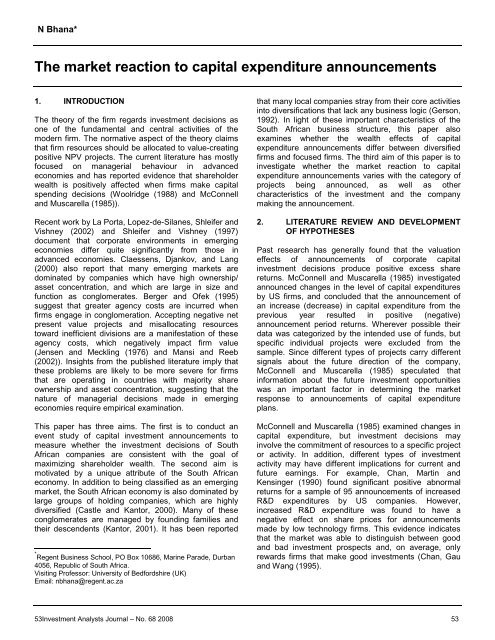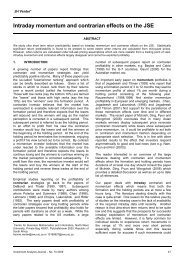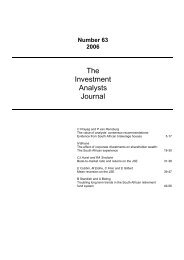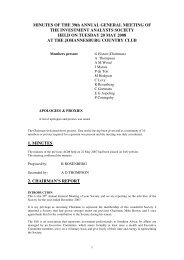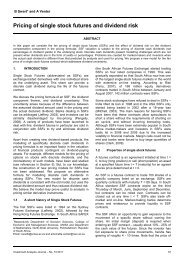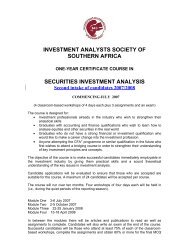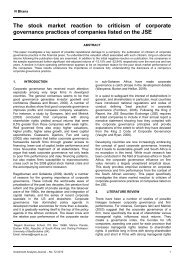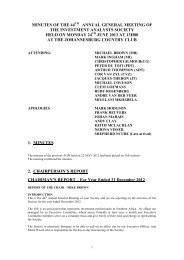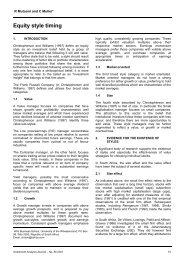The market reaction to capital expenditure announcements
The market reaction to capital expenditure announcements
The market reaction to capital expenditure announcements
You also want an ePaper? Increase the reach of your titles
YUMPU automatically turns print PDFs into web optimized ePapers that Google loves.
N Bhana*<br />
<strong>The</strong> <strong>market</strong> <strong>reaction</strong> <strong>to</strong> <strong>capital</strong> <strong>expenditure</strong> <strong>announcements</strong><br />
<strong>The</strong> <strong>market</strong> <strong>reaction</strong> <strong>to</strong> <strong>capital</strong> <strong>expenditure</strong> <strong>announcements</strong><br />
1. INTRODUCTION *<br />
<strong>The</strong> theory of the firm regards investment decisions as<br />
one of the fundamental and central activities of the<br />
modern firm. <strong>The</strong> normative aspect of the theory claims<br />
that firm resources should be allocated <strong>to</strong> value-creating<br />
positive NPV projects. <strong>The</strong> current literature has mostly<br />
focused on managerial behaviour in advanced<br />
economies and has reported evidence that shareholder<br />
wealth is positively affected when firms make <strong>capital</strong><br />
spending decisions (Woolridge (1988) and McConnell<br />
and Muscarella (1985)).<br />
Recent work by La Porta, Lopez-de-Silanes, Shleifer and<br />
Vishney (2002) and Shleifer and Vishney (1997)<br />
document that corporate environments in emerging<br />
economies differ quite significantly from those in<br />
advanced economies. Claessens, Djankov, and Lang<br />
(2000) also report that many emerging <strong>market</strong>s are<br />
dominated by companies which have high ownership/<br />
asset concentration, and which are large in size and<br />
function as conglomerates. Berger and Ofek (1995)<br />
suggest that greater agency costs are incurred when<br />
firms engage in conglomeration. Accepting negative net<br />
present value projects and misallocating resources<br />
<strong>to</strong>ward inefficient divisions are a manifestation of these<br />
agency costs, which negatively impact firm value<br />
(Jensen and Meckling (1976) and Mansi and Reeb<br />
(2002)). Insights from the published literature imply that<br />
these problems are likely <strong>to</strong> be more severe for firms<br />
that are operating in countries with majority share<br />
ownership and asset concentration, suggesting that the<br />
nature of managerial decisions made in emerging<br />
economies require empirical examination.<br />
This paper has three aims. <strong>The</strong> first is <strong>to</strong> conduct an<br />
event study of <strong>capital</strong> investment <strong>announcements</strong> <strong>to</strong><br />
measure whether the investment decisions of South<br />
African companies are consistent with the goal of<br />
maximizing shareholder wealth. <strong>The</strong> second aim is<br />
motivated by a unique attribute of the South African<br />
economy. In addition <strong>to</strong> being classified as an emerging<br />
<strong>market</strong>, the South African economy is also dominated by<br />
large groups of holding companies, which are highly<br />
diversified (Castle and Kan<strong>to</strong>r, 2000). Many of these<br />
conglomerates are managed by founding families and<br />
their descendents (Kan<strong>to</strong>r, 2001). It has been reported<br />
* Regent Business School, PO Box 10686, Marine Parade, Durban<br />
4056, Republic of South Africa.<br />
Visiting Professor: University of Bedfordshire (UK)<br />
Email: nbhana@regent.ac.za<br />
that many local companies stray from their core activities<br />
in<strong>to</strong> diversifications that lack any business logic (Gerson,<br />
1992). In light of these important characteristics of the<br />
South African business structure, this paper also<br />
examines whether the wealth effects of <strong>capital</strong><br />
<strong>expenditure</strong> <strong>announcements</strong> differ between diversified<br />
firms and focused firms. <strong>The</strong> third aim of this paper is <strong>to</strong><br />
investigate whether the <strong>market</strong> <strong>reaction</strong> <strong>to</strong> <strong>capital</strong><br />
<strong>expenditure</strong> <strong>announcements</strong> varies with the category of<br />
projects being announced, as well as other<br />
characteristics of the investment and the company<br />
making the announcement.<br />
2. LITERATURE REVIEW AND DEVELOPMENT<br />
OF HYPOTHESES<br />
Past research has generally found that the valuation<br />
effects of <strong>announcements</strong> of corporate <strong>capital</strong><br />
investment decisions produce positive excess share<br />
returns. McConnell and Muscarella (1985) investigated<br />
announced changes in the level of <strong>capital</strong> <strong>expenditure</strong>s<br />
by US firms, and concluded that the announcement of<br />
an increase (decrease) in <strong>capital</strong> <strong>expenditure</strong> from the<br />
previous year resulted in positive (negative)<br />
announcement period returns. Wherever possible their<br />
data was categorized by the intended use of funds, but<br />
specific individual projects were excluded from the<br />
sample. Since different types of projects carry different<br />
signals about the future direction of the company,<br />
McConnell and Muscarella (1985) speculated that<br />
information about the future investment opportunities<br />
was an important fac<strong>to</strong>r in determining the <strong>market</strong><br />
response <strong>to</strong> <strong>announcements</strong> of <strong>capital</strong> <strong>expenditure</strong><br />
plans.<br />
McConnell and Muscarella (1985) examined changes in<br />
<strong>capital</strong> <strong>expenditure</strong>, but investment decisions may<br />
involve the commitment of resources <strong>to</strong> a specific project<br />
or activity. In addition, different types of investment<br />
activity may have different implications for current and<br />
future earnings. For example, Chan, Martin and<br />
Kensinger (1990) found significant positive abnormal<br />
returns for a sample of 95 <strong>announcements</strong> of increased<br />
R&D <strong>expenditure</strong>s by US companies. However,<br />
increased R&D <strong>expenditure</strong> was found <strong>to</strong> have a<br />
negative effect on share prices for <strong>announcements</strong><br />
made by low technology firms. This evidence indicates<br />
that the <strong>market</strong> was able <strong>to</strong> distinguish between good<br />
and bad investment prospects and, on average, only<br />
rewards firms that make good investments (Chan, Gau<br />
and Wang (1995).<br />
53Investment Analysts Journal – No. 68 2008 53
<strong>The</strong> <strong>market</strong> <strong>reaction</strong> <strong>to</strong> <strong>capital</strong> <strong>expenditure</strong> <strong>announcements</strong><br />
Investments in projects that reduce operating costs may<br />
also provide signals regarding the firm‟s investment<br />
opportunities. For example, Chan et al. (1995) identified<br />
positive abnormal returns earned by US firms<br />
announcing headquarters relocation decisions but<br />
negative abnormal returns for plant relocation<br />
<strong>announcements</strong>. However, where the relocation was<br />
motivated by business expansion or cost savings the<br />
<strong>market</strong> reacted positively whilst the <strong>market</strong> reacted<br />
negatively <strong>to</strong> decisions which would result in reduced<br />
capacity.<br />
One way <strong>to</strong> enter new <strong>market</strong>s, reduce production costs<br />
or share R&D costs is <strong>to</strong> form joint ventures. McConnell<br />
and Nantell (1985) found that <strong>announcements</strong> of<br />
domestic joint ventures resulted in significant positive<br />
announcement day returns. McConnell and Nantell<br />
speculated that the similarities between the <strong>market</strong><br />
<strong>reaction</strong>s <strong>to</strong> mergers and joint ventures might indicate an<br />
inter-corporate synergy effect as the source of the gains<br />
<strong>to</strong> shareholders, although they did not test this<br />
proposition. On the other hand, Chung, Koford, and Lee<br />
(1993) found <strong>announcements</strong> of international joint<br />
ventures by US firms had a negative effect on US firm<br />
values. Possible explanations for the negative wealth<br />
effects are fears regarding victimisation by hostile<br />
partners, diffusion of high-technologies and<br />
management conflicts (Chung et al., 1993).<br />
Bur<strong>to</strong>n, Lonie and Power (1999) examined UK<br />
<strong>announcements</strong> of joint ventures classified as<br />
immediately cash-generating and non-immediately cashgenerating<br />
investments. <strong>The</strong>y found significant positive<br />
returns for joint ventures but not for either of the other<br />
single company categories. <strong>The</strong>ir cross-sectional<br />
regressions examined whether a dummy variable for the<br />
availability of prior funding, announcement size,<br />
company size and <strong>market</strong>-<strong>to</strong>-book ratio were significant<br />
determinants of <strong>market</strong> <strong>reaction</strong> <strong>to</strong> individual <strong>capital</strong><br />
<strong>expenditure</strong> projects. <strong>The</strong> only significant variable was<br />
the announcement size for immediately cash-generating<br />
investments. Bur<strong>to</strong>n et al. (1999) do not fully explore the<br />
cause of the higher abnormal returns associated with<br />
joint ventures than with individual firm investment<br />
<strong>announcements</strong>, but suggest that it may be associated<br />
with synergistic gains, possibly associated with reduction<br />
in costs, spreading of risks, and the cross-fertilization of<br />
ideas.<br />
Johnson and Hous<strong>to</strong>n (2000) have found that joint<br />
ventures are being used for risky and complex<br />
transactions and for spreading costs. Frohls, Keown,<br />
McNabb and Martin (1998) similarly found joint ventures<br />
<strong>to</strong> be particularly beneficial when entering emerging<br />
<strong>market</strong>s, which may be riskier (for US companies) than<br />
transactions in other industrialized <strong>market</strong>s. Analysing<br />
strategic alliances rather than joint ventures, Chan,<br />
Kensinger, Keown and Martin (1997) found higher<br />
wealth creation where there was a transfer or pooling of<br />
technical knowledge.<br />
Woolridge and Snow (1990) investigated the <strong>market</strong><br />
<strong>reaction</strong> <strong>to</strong> various types of <strong>capital</strong> <strong>expenditure</strong>s. <strong>The</strong>y<br />
found that <strong>market</strong> <strong>reaction</strong>s <strong>to</strong> strategic investment<br />
<strong>announcements</strong> by US firms, which were generally<br />
significant and positive, were more consistent with<br />
shareholder wealth maximization than either “short-termism”<br />
imposed by institutional shareholders or their no<br />
<strong>reaction</strong> “rational expectations” hypothesis. Four types of<br />
<strong>capital</strong> investment <strong>announcements</strong> were analysed and<br />
significant abnormal returns were identified for each<br />
type: joint ventures (two-day cumulative <strong>market</strong>-adjusted<br />
return of 0,80%); R&D (1,13%); <strong>capital</strong> <strong>expenditure</strong><br />
(0,36%), and product/ <strong>market</strong> diversification (0,69%).<br />
<strong>The</strong> results of the Woolridge and Snow (1990) study<br />
suggest that not only are abnormal returns likely <strong>to</strong> be<br />
positive (0,64% overall), but that there may be<br />
identifiable differences in the level of abnormal returns<br />
for different types of <strong>capital</strong> <strong>expenditure</strong> <strong>announcements</strong>.<br />
Woolridge and Snow (1990) also examined whether<br />
project size (relative <strong>to</strong> the size of the firm) and project<br />
duration were important determinants of abnormal<br />
returns. <strong>The</strong>y found the <strong>market</strong> <strong>reaction</strong> <strong>to</strong> be identical<br />
for small and large projects, although they noted that the<br />
sub-sample for which classification was possible was<br />
mainly comprised of plant and equipment <strong>expenditure</strong>s.<br />
<strong>The</strong> <strong>market</strong> <strong>reaction</strong> <strong>to</strong> projects of short-term (less than<br />
three years) or long-term duration was also virtually<br />
identical, thus rejecting the hypothesis that the <strong>market</strong><br />
discouraged firms from making long-term investments.<br />
From a close analysis of the literature, it was decided <strong>to</strong><br />
test whether the shareholder wealth maximization or the<br />
rational expectations hypothesis is applicable <strong>to</strong> South<br />
African companies making <strong>capital</strong> <strong>expenditure</strong><br />
<strong>announcements</strong>. <strong>The</strong> following hypothesis was tested:<br />
H 1 : In a competitive <strong>market</strong> funds for <strong>capital</strong> <strong>expenditure</strong><br />
will be allocated <strong>to</strong> projects that enhance the firm‟s longterm<br />
prospects. <strong>The</strong>refore, the s<strong>to</strong>ck <strong>market</strong> will react<br />
positively <strong>to</strong> corporate <strong>announcements</strong> of <strong>capital</strong><br />
<strong>expenditure</strong> decisions <strong>to</strong> the extent that it enhances<br />
long-term profitability and maximizes firm value.<br />
As suggested by Wernfelt and Montgomery (1988) and<br />
Lang and Stulz (1994), focused firms tend <strong>to</strong> have better<br />
investment opportunities than highly diversified firms.<br />
Since firms with better investment opportunities are<br />
more likely <strong>to</strong> invest in positive net present value (NPV)<br />
projects (Lang, Stulz, and Walking (1991)), <strong>capital</strong><br />
investments by focused firms will be more worthwhile<br />
54 Investment Analysts Journal – No. 68 2008
<strong>The</strong> <strong>market</strong> <strong>reaction</strong> <strong>to</strong> <strong>capital</strong> <strong>expenditure</strong> <strong>announcements</strong><br />
than those by diversified companies. Diversified firms<br />
have poorer investment opportunities and tend <strong>to</strong> invest<br />
more in negative NPV projects, because of a crosssubsidization<br />
problem (Scharfstein and Stein (2000)), a<br />
relatively greater propensity <strong>to</strong> engage in empire building<br />
(Jensen, 1986) power grabbing (Rajan, Servaes, and<br />
Zingales (2000)), or weaker management incentives <strong>to</strong><br />
maximize shareholder value (Denis, Denis and Sarin<br />
(1997)). <strong>The</strong>refore <strong>capital</strong> investments by diversified<br />
companies have a greater potential <strong>to</strong> be wasteful. To<br />
test the expected differential <strong>market</strong> <strong>reaction</strong> <strong>to</strong> <strong>capital</strong><br />
<strong>expenditure</strong> <strong>announcements</strong> by focused and diversified<br />
companies, the following hypothesis is tested:<br />
H 2 : <strong>The</strong> share <strong>market</strong> will react more favourably <strong>to</strong><br />
<strong>capital</strong> <strong>expenditure</strong> <strong>announcements</strong> by focused<br />
companies because of inves<strong>to</strong>r perception that they are<br />
more likely <strong>to</strong> result in shareholder wealth maximization<br />
than those by diversified companies which are perceived<br />
<strong>to</strong> be associated with sub-optimal allocation of<br />
investment funds.<br />
3. CLASSIFICATION OF CAPITAL<br />
EXPENDITURE DECISIONS<br />
<strong>The</strong> financial literature provides various systems for<br />
classifying <strong>capital</strong> investment decisions for project<br />
appraisal (Kester, 1984). Since we attempt <strong>to</strong> appraise<br />
projects in this paper, categories of <strong>capital</strong> <strong>expenditure</strong><br />
decisions analysed were selected from the classification<br />
developed by Kester.<br />
By classifying investments according <strong>to</strong> the primary<br />
activity or function, it is possible <strong>to</strong> examine the<br />
underlying value creating characteristics. <strong>The</strong>se<br />
characteristics are indicative of the level of follow-on<br />
investment opportunities, which are provided by a <strong>capital</strong><br />
investment decision. Kester (1984) argued that the firm<br />
must have an appropriate mix of two types of investment<br />
as part of its investment strategy – “compound growth<br />
options” and “simple growth options”. <strong>The</strong> “compound<br />
growth options” category includes those investments<br />
such as R&D and product/<strong>market</strong> diversification, which<br />
are expected <strong>to</strong> create growth options and generate<br />
revenue in the longer term (Dixit and Pindyck, 1995).<br />
<strong>The</strong> investments included in the “simple growth options”<br />
category, such as new plant investments or cost<br />
reduction investments, involve a decision <strong>to</strong> extend<br />
growth options (Kester, 1984). We aggregate the R&D<br />
and product/<strong>market</strong> categories <strong>to</strong> provide the “create”<br />
category and the asset <strong>expenditure</strong> and cost reduction<br />
categories <strong>to</strong> provide the “extend” category.<br />
Following these guidelines, the investment categories<br />
used here are as follows:<br />
<br />
<br />
<br />
<br />
Cost reduction projects involve the commitment of<br />
resources <strong>to</strong> programmes in which the costs of<br />
operating the current line of business are reduced.<br />
<strong>The</strong>se are recognised as being low risk projects<br />
(Merrett and Sykes, 1973). However, such projects<br />
would not be expected <strong>to</strong> create follow-on<br />
investment opportunities.<br />
Asset <strong>expenditure</strong> projects involve <strong>expenditure</strong> on<br />
plant, equipment and machinery for expansion or<br />
maintenance of the current line of business. <strong>The</strong><br />
level of risk associated with replacement projects is<br />
similar <strong>to</strong> that of current production while<br />
investments that require an increased <strong>market</strong> share<br />
would have a level of risk greater than that of<br />
current production. Asset <strong>expenditure</strong> might be<br />
considered as the extension of a “growth option”<br />
that was previously created.<br />
Product/<strong>market</strong> diversification projects involve the<br />
commitment of resources in an attempt <strong>to</strong> increase<br />
<strong>market</strong> share in new <strong>market</strong>s or in new product<br />
areas. This category includes new product launches<br />
and the <strong>market</strong>ing of current products in new<br />
geographical areas. Diversification in<strong>to</strong> new<br />
<strong>market</strong>s and new product areas is likely <strong>to</strong> have<br />
relatively high level of risk.<br />
Research and development (R&D) projects involve<br />
the commitment of resources <strong>to</strong> work directed<br />
<strong>to</strong>wards the innovation, introduction and<br />
improvement of products and processes. Such<br />
projects involve very little certainty about where and<br />
when the returns will occur and consequently a<br />
large proportion of the value of an R&D project is<br />
determined by the ability <strong>to</strong> defer the follow-on<br />
investment and the exclusiveness of rights <strong>to</strong><br />
research discoveries.<br />
<strong>The</strong> classification of a project may depend on the<br />
corporate environment in which it is undertaken. A<br />
company that undertakes a cost reduction project or<br />
expands within its existing line of business is extending<br />
existing investment. <strong>The</strong> opportunity <strong>to</strong> invest in this way<br />
will have been apparent <strong>to</strong> inves<strong>to</strong>rs and will have been<br />
included in the firm‟s <strong>market</strong> value. Cost reduction and<br />
asset <strong>expenditure</strong> projects thus involve the maintenance<br />
and extension of current investment opportunities. If a<br />
company enters in<strong>to</strong> a new line of business, we suggest<br />
that this will be less likely <strong>to</strong> have been anticipated by<br />
the <strong>market</strong>. Entry in<strong>to</strong> a new line will carry with it options<br />
<strong>to</strong> grow and expand the new operation. Such<br />
investments may thus create follow-on investment<br />
opportunities. Our categorization of investment projects<br />
therefore depends partly on the character of the<br />
investment project considered in isolation, but also <strong>to</strong><br />
55Investment Analysts Journal – No. 68 2008 55
<strong>The</strong> <strong>market</strong> <strong>reaction</strong> <strong>to</strong> <strong>capital</strong> <strong>expenditure</strong> <strong>announcements</strong><br />
some extent, on the relationship between the project and<br />
the existing operations of the firm.<br />
4. SAMPLE SELECTION AND RESEARCH<br />
METHODOLOGY<br />
4.1 Sample selection<br />
<strong>The</strong> sample consists of all <strong>capital</strong> <strong>expenditure</strong><br />
<strong>announcements</strong> made by companies listed on the JSE<br />
during the period 1 January 1995 <strong>to</strong> 31 December 2004.<br />
To be included in the final sample, the <strong>announcements</strong><br />
had <strong>to</strong> meet the following criteria:<br />
1. <strong>The</strong> announcing company must have its daily share<br />
price data available for the full 120-day estimation<br />
period and also the 21-day period covering the<br />
event study.<br />
2. Announcements must contain definite plans rather<br />
than conjectures about the future investments.<br />
Furthermore, <strong>announcements</strong> must include<br />
information about the approximate size and the<br />
actual use of funds.<br />
3. <strong>The</strong> company must not have any other<br />
announcement during the 10 days before and 10<br />
days after the <strong>capital</strong> <strong>expenditure</strong> announcement.<br />
A <strong>to</strong>tal of 378 <strong>capital</strong> <strong>expenditure</strong> <strong>announcements</strong> met<br />
the criteria and were included in the final sample. <strong>The</strong><br />
data related <strong>to</strong> the <strong>announcements</strong> were obtained from<br />
Reuters News, which provided selected news services<br />
s<strong>to</strong>ries from Business Day and other financial<br />
publications. This publication was used <strong>to</strong> identify news<br />
related <strong>to</strong> the <strong>capital</strong> <strong>expenditure</strong> <strong>announcements</strong> during<br />
the period of the investigation. <strong>The</strong> <strong>announcements</strong> were<br />
confirmed from Business Day and the database of JSE<br />
SENS, which commenced providing company specific<br />
<strong>announcements</strong> by listed companies from March 1998.<br />
<strong>The</strong> data required from the financial statements of<br />
companies included in the sample and the JSE All Share<br />
Index were obtained from the McGregor‟s BFANet<br />
database. All financial data required <strong>to</strong> perform the OLS<br />
regression were also obtained from these sources.<br />
It has been shown that shareholders prefer the concept<br />
of „pure plays” and single-minded focus and that the<br />
<strong>market</strong> reward companies that meet these criteria<br />
(Gadad and Thomas, 2005). Chen (2006) showed that<br />
for companies listed on the NYSE, the <strong>market</strong> <strong>reaction</strong> <strong>to</strong><br />
<strong>capital</strong> <strong>expenditure</strong> <strong>announcements</strong> are more favourable<br />
for focused companies than for diversified companies.<br />
<strong>The</strong>refore, it was decided <strong>to</strong> test if a similar trend exists<br />
for companies listed on the JSE. <strong>The</strong> methodology used<br />
by Chen (2006: 343) <strong>to</strong> measure company focus is used<br />
for this South African study. <strong>The</strong> basic concept is that<br />
the more concentrated the firm‟s sales/assets within a<br />
few (many) of its business segments the more focused<br />
(diversified) are its operations.<br />
<strong>The</strong> financial statements of all companies associated<br />
with <strong>capital</strong> <strong>expenditure</strong> <strong>announcements</strong> were<br />
investigated <strong>to</strong> determine the number of clearly defined<br />
industries and segments in which they operated.<br />
Companies operating in a single segment were<br />
classified as focused companies and those operating in<br />
multiple segments were classified as diversified<br />
companies. <strong>The</strong> final sample comprises 378 <strong>capital</strong><br />
<strong>expenditure</strong> <strong>announcements</strong>: 123 by focused companies<br />
and 255 by diversified companies.<br />
4.2 Research methodology<br />
<strong>The</strong> event study methodology developed by Brown and<br />
Warner (1985) was used <strong>to</strong> determine the excess<br />
returns around the announcement day. An estimation<br />
period from day –180 <strong>to</strong> day –11 is used <strong>to</strong> calculate the<br />
parameters, A i and B i of the following <strong>market</strong> model:<br />
R it = A i + B i R mt + E it … (1)<br />
Where R it is the rate of return of the <strong>capital</strong> investment<br />
company i on day t. R mt is the rate of return on the<br />
<strong>market</strong> portfolio represented by the JSE All Share Index<br />
on day t. B i is the estimated <strong>market</strong> risk of share i. A i is<br />
the estimated intercept. E it is the error term on day t; E<br />
(E it ) = 0. <strong>The</strong> estimated parameters, B i and A i are used<br />
<strong>to</strong> calculate the excess returns, E it from day –10 <strong>to</strong> day<br />
10 for each share as follows:<br />
E it = R it – A i – B i R mt … (2)<br />
To test the statistical significance of these excess<br />
returns, we calculate the following statistics:<br />
n<br />
1<br />
AR t = Eit<br />
… (3)<br />
n <br />
i 1<br />
D<br />
CAR = ARt<br />
… (4)<br />
where:<br />
tD<br />
AR t is the average excess return of all <strong>capital</strong><br />
<strong>expenditure</strong> announcing companies on a given day t;<br />
CAR is the cumulative average excess returns from day<br />
–D <strong>to</strong> day D, and N is the number of companies.<br />
<strong>The</strong> method employed by Dimson (1979) and refined by<br />
Cohen, Hawawini, Maier, Schwartz and Whitcomb<br />
56 Investment Analysts Journal – No. 68 2008
<strong>The</strong> <strong>market</strong> <strong>reaction</strong> <strong>to</strong> <strong>capital</strong> <strong>expenditure</strong> <strong>announcements</strong><br />
(1983) <strong>to</strong> overcome the problem of beta underestimation<br />
caused by serial correlation was used when calculating<br />
the beta values for companies in the sample. Bradfield<br />
and Barr (1989) conducted a sensitivity study of beta<br />
values of JSE listed companies. <strong>The</strong>y showed that there<br />
is a statistical significance for two lagged terms, the<br />
contemporaneous term and one leading term. <strong>The</strong><br />
Bradfield and Barr procedure was therefore used <strong>to</strong><br />
calculate the beta values for companies identified as<br />
events.<br />
5. EMPIRICAL RESULTS<br />
5.1 Shareholder <strong>reaction</strong> <strong>to</strong> <strong>capital</strong> <strong>expenditure</strong><br />
<strong>announcements</strong><br />
Panel A of Table 1 reports the abnormal returns<br />
surrounding the 378 <strong>capital</strong> <strong>expenditure</strong> <strong>announcements</strong><br />
made by JSE listed companies during the 1995-2004<br />
period. <strong>The</strong> full sample was stratified <strong>to</strong> enable the<br />
<strong>market</strong> <strong>reaction</strong> of focused and diversified companies <strong>to</strong><br />
be analysed separately. <strong>The</strong> investigation period was 21<br />
days (-10 <strong>to</strong> 10). <strong>The</strong> <strong>market</strong> <strong>reaction</strong> is random in<br />
nature and becomes systematically positive only in the<br />
four days before the announcement, the announcement<br />
day itself, and the day after the announcement.<br />
<strong>The</strong>refore, the results are reported only for the 6-day<br />
period (-4 <strong>to</strong> 1).<br />
For the full sample, on average, the <strong>market</strong> <strong>reaction</strong> is<br />
positive and significant three days prior <strong>to</strong>, and the<br />
announcement day itself. <strong>The</strong> abnormal returns for days<br />
–3, -2 and –1 are 0,21%, 0,37% and 0,27% respectively.<br />
<strong>The</strong> announcement day return is 0,22%. <strong>The</strong>se finding<br />
indicate that although public <strong>announcements</strong> of <strong>capital</strong><br />
<strong>expenditure</strong> decisions produced statistically significant<br />
positive abnormal returns, the share value change<br />
associated with insider information is greater than the<br />
public information released on announcement day.<br />
Panel A also reports the share <strong>market</strong> <strong>reaction</strong> <strong>to</strong> <strong>capital</strong><br />
<strong>expenditure</strong> <strong>announcements</strong> by companies classified as<br />
focused and diversified companies. For the focused<br />
companies the abnormal returns are positive and<br />
statistically significant for the pre-announcement period<br />
(days –3, -2 and –1) amounting <strong>to</strong> 0,25%, 0,65% and<br />
0,42% respectively. Furthermore, the announcement<br />
and post-announcement returns (days 0 and 1) are<br />
0,31% and 0,24% respectively and are also significant.<br />
For diversified companies statistically significant positive<br />
returns are observed only in the pre-announcement<br />
period (days –2 and –1) amounting <strong>to</strong> 0,26% and 0,20%<br />
respectively.<br />
Panel B of Table 1 presents cumulative abnormal<br />
returns (CAR) for the window period of (-4,1) for the full<br />
sample and also the focused and diversified companies.<br />
<strong>The</strong> <strong>to</strong>tal wealth effects of <strong>capital</strong> <strong>expenditure</strong> decisions<br />
by the full sample of 378 <strong>announcements</strong> is 1,35% and<br />
is statistically significant at the 5% level. This finding is<br />
consistent with the view that the <strong>market</strong> does react <strong>to</strong><br />
company-specific <strong>capital</strong> <strong>expenditure</strong> <strong>announcements</strong><br />
and also supports hypothesis 1 which asserts that the<br />
<strong>market</strong> <strong>reaction</strong> is associated with the prospects for<br />
enhancing long-term profitability and maximizing firm<br />
value. <strong>The</strong> results are also consistent with similar<br />
findings associated with US and non-US firms (Esther et<br />
al., 2003).<br />
Panel B of Table 1 shows that the CAR value for<br />
focused company is 1,99% and is statistically significant<br />
at the 1% level. <strong>The</strong> corresponding CAR value for<br />
diversified companies is 0.98% and is statistically<br />
significant at the 10% level. <strong>The</strong> mean difference test of<br />
CAR between the two portfolios is statistically significant<br />
at the 5% level (with a t-statistic of 1,72). We observe<br />
that the wealth effects of <strong>capital</strong> <strong>expenditure</strong> decisions<br />
by focused companies are more favourably rated than<br />
those by diversified companies. <strong>The</strong> finding of this study<br />
also supports hypothesis 2, which asserts that focused<br />
companies are perceived <strong>to</strong> be more likely <strong>to</strong> emphasize<br />
the maximization of shareholder wealth than diversified<br />
companies. <strong>The</strong> findings of this investigation are also<br />
consistent with a recent study by Ferris, Kim and<br />
Kitsabunnarat (2003) who found that diversified<br />
companies experience loss of shareholder wealth<br />
because of the tendency of managers <strong>to</strong> over-invest and<br />
deviate from the wealth maximization principle.<br />
5.2 Analysis of announcement returns by<br />
investment class<br />
<strong>The</strong> abnormal return of the overall dataset for each<br />
investment class is presented in Table 2. <strong>The</strong> overall<br />
mean abnormal return of 1,35% is slightly higher than<br />
that reported by previous overseas studies. <strong>The</strong> median<br />
is lower (0,41%), but still highly significant. <strong>The</strong> null<br />
hypothesis that abnormal returns are zero when <strong>capital</strong><br />
investment news is announced can be rejected for the<br />
sample as a whole. For all categories of investment<br />
except cost reduction projects, the median abnormal<br />
return is significantly different <strong>to</strong> zero at the 1%<br />
confidence level.<br />
57Investment Analysts Journal – No. 68 2008 57
<strong>The</strong> <strong>market</strong> <strong>reaction</strong> <strong>to</strong> <strong>capital</strong> <strong>expenditure</strong> <strong>announcements</strong><br />
Table 1: Abnormal returns (AR) and cumulative abnormal returns (CAR) around announcement date<br />
of <strong>capital</strong> <strong>expenditure</strong>s<br />
Panel A: Abnormal Returns<br />
Full Sample(n=378) Focused Companies n=123 Diversified Companies(n=255)<br />
AR (%) t-value AR (%) t-value AR (%) t-value<br />
-4 0,0859 0,74 0,1241 1,12 0,0675 0,61<br />
-3 0,2121 1,70* 0,2456 2,13* 0,1163 1,07<br />
-2 0,3676 3,13*** 0,6472 3,59*** 0,2614 2,35**<br />
-1 0,2734 2,40** 0,4240 3,07*** 0,2008 1,72*<br />
0 0,2217 1,79* 0,3126 2,98*** 0,1778 1,43<br />
1 0,1852 1,51 0,2405 1,98* 0,1585 1,48<br />
Panel B: Cumulative Abnormal Returns CAR=(-4,1)<br />
Full Sample Focused Companies Diversified Companies<br />
CAR (%) t-value CAR (%) t-value CAR (%) t-value<br />
1,3459 2,46** 1,9940 a 3,53*** 0,9823 1,94*<br />
* Significant at the 10% level<br />
** Significant at the 5% level<br />
*** Significant at the 1% level<br />
a<br />
<strong>The</strong> mean difference test of focused companies and diversified companies portfolios is statistically significant at the 5% level (t-statistic of 1,72)<br />
Table 2: Abnormal Returns for different classes of <strong>capital</strong> <strong>expenditure</strong> <strong>announcements</strong><br />
Class Cases Mean Median Standard Deviation<br />
Full Sample 378 0,0135** 0,0041** 0,0462<br />
Create Future Growth a 136 0,0331** 0,0063** 0,0535<br />
Extend Existing Growth b 242 0,0035 0,0019* 0,0374<br />
Research and Development 23 0,0369** 0,0064** 0,0630<br />
Product/Market Diversification 113 0,0323** 0,0082** 0,0589<br />
Asset Expenditure 210 0,0046 0,0021** 0,0364<br />
Cost Reduction 32 -0,0037 0,0009 0,0297<br />
Joint Ventures c 28 0,0192** 0,0035** 0,0548<br />
* Significant at the 10% level.<br />
** Significant at the 5% level.<br />
a<br />
Create category compromises the R and D and Product/Market Diversification categories combined.<br />
b<br />
Extend category is a combination of Asset Expenditure and Cost Reduction categories.<br />
c<br />
<strong>The</strong> Joint Ventures category consists of those projects (of all types) from the whole sample, which were undertaken with one or more<br />
partners.<br />
Dixit and Pindyck (1995) have suggested that managers<br />
should consider the implications of <strong>capital</strong> investments<br />
for the investment opportunities of the firm when making<br />
decisions regarding the financing of <strong>capital</strong> projects. If<br />
the <strong>market</strong> understands these implications, it would be<br />
expected that investments, which “create” growth<br />
options would be valued more highly than investments<br />
that did not. <strong>The</strong> mean abnormal return for the set of<br />
<strong>announcements</strong>, which would be expected <strong>to</strong> “create”<br />
future growth options was 3,31% compared with 0,35%<br />
for investments, which “extend” existing growth options.<br />
Both the mean and median abnormal returns were<br />
significant for the “create” investments while only the<br />
median value was significant for the set of “extend”<br />
investments. <strong>The</strong> <strong>market</strong>-adjusted returns for the<br />
investments, which “create” growth options are<br />
significantly greater than the <strong>market</strong>-adjusted returns for<br />
investments which “extend” investments options,<br />
according <strong>to</strong> a Mann-Whitney test and an independent<br />
samples t-test at the 5% level.<br />
<strong>The</strong> larger standard deviation for the set of investments<br />
that create investment opportunities is indicative of<br />
larger information flow. <strong>The</strong> difference in the variation<br />
between the categories was tested and found <strong>to</strong> be<br />
significant at the 1% level using an F-test. <strong>The</strong>se<br />
findings are consistent with the hypothesis that the<br />
<strong>market</strong> valuation of <strong>capital</strong> investment is <strong>to</strong> some extent<br />
determined by the value of follow-on investment<br />
opportunities. Furthermore, the commonly expressed<br />
hypothesis that the <strong>capital</strong> <strong>market</strong> is myopic (Woolridge<br />
and Snow, 1990) and prefers short-term returns can be<br />
questioned in light of these results.<br />
Various studies have provided evidence of differential<br />
share price performance for different types of <strong>capital</strong><br />
investments. For example Chan et al. (1990) found a<br />
58 Investment Analysts Journal – No. 68 2008
<strong>The</strong> <strong>market</strong> <strong>reaction</strong> <strong>to</strong> <strong>capital</strong> <strong>expenditure</strong> <strong>announcements</strong><br />
two-day cumulative abnormal of 1,38% for a sample of<br />
R&D <strong>announcements</strong>. Chaney and Devinney (1992)<br />
found a three-day excess return of 0,6% for new product<br />
innovations and Woolridge and Snow (1990) report twoday<br />
cumulative returns of 1,13% for R&D<br />
<strong>announcements</strong>, a 0,69% for product or <strong>market</strong><br />
diversification and a 0,36% for <strong>capital</strong> <strong>expenditure</strong>s. <strong>The</strong><br />
mean return for each of the categories obtained in this<br />
paper are consistent with the previous studies and<br />
support the hypothesis that investments that create<br />
investment opportunities result in higher mean abnormal<br />
returns than investments that extend growth options.<br />
<strong>The</strong> category of R&D exhibited the largest mean<br />
abnormal return (3,69%) followed by product/<strong>market</strong><br />
diversification (3,23%) and asset <strong>expenditure</strong> (0,46%).<br />
<strong>The</strong> mean abnormal return for cost reduction projects<br />
was –0,37%. <strong>The</strong> category of asset <strong>expenditure</strong>s has a<br />
low mean and standard deviation, which perhaps<br />
indicates that the information has already been<br />
impounded in<strong>to</strong> the share price as part of its investment<br />
opportunities or that such <strong>capital</strong> <strong>expenditure</strong>s are long<br />
anticipated as part of the ongoing maintenance of<br />
existing production.<br />
Of the 378 investments announced, 28 were undertaken<br />
as joint ventures. <strong>The</strong> mean abnormal return for the set<br />
of joint ventures (1,92%) is higher than that for the<br />
sample as a whole (1,35%). This is consistent with the<br />
findings of Bur<strong>to</strong>n et al. (1999) for the UK and Woolridge<br />
and Snow (1990) for the US, who also found the<br />
abnormal returns from investment <strong>announcements</strong> <strong>to</strong> be<br />
higher for joint ventures than for the sample as a whole.<br />
5.3 Cross-sectional analysis<br />
It has been established that there is a positive and<br />
significant abnormal return when <strong>capital</strong> investments are<br />
announced and also that the abnormal returns are<br />
significantly higher for companies classified as focused<br />
when compared <strong>to</strong> those who are regarded as<br />
diversified. We have also seen that certain categories of<br />
investment decisions have higher average abnormal<br />
returns. In this section we use regression analysis <strong>to</strong><br />
explain the magnitude and sign of abnormal returns.<br />
Using cross-sectional regressions we can examine the<br />
relationship between abnormal returns for the 6-day<br />
period (-4 <strong>to</strong> 1) and a number of contingent variables.<br />
<strong>The</strong> regression analysis was adopted from Bur<strong>to</strong>n et al.<br />
(1999) and was conducted according <strong>to</strong> equation (5):<br />
ε i = α + β 1 log s + β 2 jv + β 3 cf + β 4 cp + β 5ps +<br />
β 6 D 1 + β 7D 2 + β 8 D 3 + e … (5)<br />
where:<br />
ε i = abnormal return on share i,<br />
α =<br />
log s =<br />
jv =<br />
cf =<br />
cp =<br />
ps =<br />
constant,<br />
log of firm size,<br />
dummy variable for joint venture projects,<br />
company focus index,<br />
company performance variable<br />
project size<br />
D 1 , D 2 , D 3 = dummy variables representing each<br />
project type, where D 1 refers <strong>to</strong> R&D<br />
projects, D 2 <strong>to</strong> product/<strong>market</strong><br />
diversification projects, and D 3 <strong>to</strong> cost<br />
reduction projects (asset <strong>expenditure</strong><br />
projects are captured by the intercept α),<br />
e =<br />
β =<br />
error term,<br />
regression coefficients.<br />
We include relative project size because we hypothesise<br />
that projects which are large in relation <strong>to</strong> the size of the<br />
company will have a greater impact on the share price.<br />
We include firm size because large companies may use<br />
different methods <strong>to</strong> communicate with the <strong>market</strong> than<br />
small ones (Holland, (1997)). Formal <strong>announcements</strong><br />
may be less significant for larger companies. We use<br />
company performance because rising earnings are likely<br />
<strong>to</strong> indicate the presence of investment opportunities. <strong>The</strong><br />
<strong>reaction</strong>s <strong>to</strong> investment announcement might be<br />
stronger if these opportunities are already perceived by<br />
the <strong>market</strong>. Finally, we include the level of company<br />
focus as an independent variable. For any given set of<br />
investment cash flows, there is an expected positive<br />
relationship between company focus and value created<br />
for shareholders.<br />
<strong>The</strong> variable for recent company performance (cp) was<br />
taken as the percentage change in earnings per share<br />
between the last reported earnings per share and the<br />
forecast earnings per share in the current year. A similar<br />
method of examining the influence of recent<br />
performance was used by Chan et al. (1990). <strong>The</strong><br />
relative project size (ps) was calculated as the size of<br />
the project divided by the <strong>market</strong> <strong>capital</strong>isation of the<br />
company. <strong>The</strong> size of the project was taken <strong>to</strong> be the<br />
figure included in the announcement.<br />
<strong>The</strong> regression analysis is first undertaken for the<br />
dataset as a whole, with dummy variables for the various<br />
project categories. Secondly, the analysis is undertaken<br />
for each project category separately. Thirdly, the<br />
independent variables were also tested against the<br />
59Investment Analysts Journal – No. 68 2008 59
<strong>The</strong> <strong>market</strong> <strong>reaction</strong> <strong>to</strong> <strong>capital</strong> <strong>expenditure</strong> <strong>announcements</strong><br />
abnormal returns for the category of joint ventures. Table<br />
3 shows the output from the regression analysis. It is not<br />
necessary or practical <strong>to</strong> include all combinations of<br />
dependent and independent variables in the reported<br />
findings of this paper. <strong>The</strong> models were selected on the<br />
basis of the significance of correlations and on the basis<br />
of the results of prior regressions. <strong>The</strong>re was no<br />
significant relationship between the independent<br />
variables and the abnormal returns for the category of<br />
cost reduction projects.<br />
<strong>The</strong> principal finding that emerges from an inspection of<br />
Table 3 is that company focus has a significant impact<br />
on abnormal returns for the dataset as a whole and also,<br />
when regressed, on the abnormal returns for the<br />
research and development, product/<strong>market</strong><br />
diversification, and joint venture categories. <strong>The</strong><br />
adjusted R 2 for the model of product/<strong>market</strong><br />
diversification and the joint venture categories explain<br />
82% and 75% respectively of the variations in abnormal<br />
returns. In particular, the results indicate that inves<strong>to</strong>rs<br />
regard diversification by focused companies <strong>to</strong> be highly<br />
profitable as opposed <strong>to</strong> the scepticism of diversification<br />
by companies deemed not <strong>to</strong> be focused on their core<br />
operations. <strong>The</strong>se results further confirm hypothesis 2,<br />
which implies that the <strong>market</strong> responds more favourably<br />
<strong>to</strong> <strong>capital</strong> <strong>expenditure</strong> <strong>announcements</strong> by focused firms<br />
than for diversified firms.<br />
Table 3 a :Cross-Sectional regressions of abnormal returns<br />
Model Project Constant log s jv cf cp ps D 1 D 2 Adjusted R 2 F N<br />
1 Total -0,0924** -0,0089** 0,4342* 0,6925 78,1531** 362<br />
2 Total 0,0194 0,3917* 0,2312 28,3142** 211<br />
3 Total 0,0315** -0,0051** 0,0182** 0,0170** 0,0843 12,5793** 359<br />
4 Total 0,0392** -0,0073** 0,0219** 0,0873 13,8347** 370<br />
5 rd 0,0194* 0,0186** 0,3214 43,2716** 21<br />
6 rd 0,0286** 0,1542* 0,4936 53,2365** 22<br />
7 pm 0,0712** -0,0034* 0,1475* 0,8240 91,3005** 98<br />
8 pm 0,0334** 0,1092** 0,6174 74,3135** 30<br />
9 ae 0,0295** -0,0029* -0,0031* 0,0531 8,0418** 201<br />
10 jv -0,0027 0,1293** 0,7532 82,1239** 14<br />
11 jv 0,0631** -0,0022* 0,0061* 0,1027 12,9421** 25<br />
* denotes two-tailed significance of a t-test at the 5% level<br />
** denotes two-tailed significance of a t-test at the 1% level<br />
a<br />
Table 3 represents results obtained from regressing event day abnormal returns on the log of firm size (logs), a dummy variable if the<br />
project is a joint venture (jv), company focus (cf), recent company performance proxy (cp), relative project size (ps) and dummy variables<br />
for research and development (D 1) and product /<strong>market</strong> diversification (D 2).<strong>The</strong> dependant variable is noted as <strong>to</strong>tal (whole dataset), rd<br />
(research and development), pm (product/<strong>market</strong> diversification), ae (asset <strong>expenditure</strong>) or jv (joint ventures) alongside the model number.<br />
60 Investment Analysts Journal – No. 68 2008
<strong>The</strong> <strong>market</strong> <strong>reaction</strong> <strong>to</strong> <strong>capital</strong> <strong>expenditure</strong> <strong>announcements</strong><br />
<strong>The</strong> dummy variables for project categories used in<br />
model 3 are significant at the 1% confidence level. Only<br />
R&D (D 1 ) and product/<strong>market</strong> diversification (D 2 ) are<br />
included as dummy variables in the table since the cost<br />
reduction dummy variable is insignificant in all cases.<br />
This suggests that the type of project announced is an<br />
important determinant of abnormal returns and is<br />
confirmed by the evidence already cited in Table 2,<br />
which has shown that the <strong>reaction</strong> is different depending<br />
on the type of project.<br />
Model 4 comprises all the observations in the dataset<br />
and provides evidence that joint ventures are more<br />
positively received in the financial <strong>market</strong>s than single<br />
ventures, consistent with prior evidence by Bur<strong>to</strong>n et al.<br />
(1999). <strong>The</strong> coefficient for the joint ventures dummy<br />
variable is significant at the 1% level and the model<br />
predicts that the abnormal return is 2,19% higher for joint<br />
ventures than for single ventures. Further research might<br />
consider the specific characteristics of these projects<br />
which make them more attractive <strong>to</strong> financial <strong>market</strong>s.<br />
<strong>The</strong> effect of the size of the firm on security returns has<br />
been extensively studied (Fama and French, 1996). In<br />
the presence of the size effect, event studies that focus<br />
on smaller firms are likely <strong>to</strong> register positive abnormal<br />
returns relative <strong>to</strong> the average <strong>market</strong> performance,<br />
even in the absence of an event and the opposite results<br />
would hold for larger firms (Strong, 1992). Furthermore,<br />
the amount of information disclosed by a company <strong>to</strong><br />
<strong>market</strong> participants and the extent <strong>to</strong> which a company is<br />
followed by investment analysts have been found <strong>to</strong> be<br />
related <strong>to</strong> firm size (Al-Qudah, 1991).<br />
<strong>The</strong> coefficient for the log of company size is negative in<br />
all the models in which it is included. <strong>The</strong>re was no<br />
model for either cost reduction projects or for R&D<br />
projects where the log of company size was found <strong>to</strong> be<br />
significant. Company size was, however, found <strong>to</strong> be<br />
significant in models of the dataset as a whole,<br />
product/<strong>market</strong> diversification, and asset <strong>expenditure</strong>s,<br />
as well as for joint ventures. It is also notable that there<br />
is no model in which project size and company size were<br />
both significant. It would appear that that in cases where<br />
project size is announced, it dominates other forms of<br />
information about the project.<br />
<strong>The</strong> log of the <strong>market</strong> <strong>capital</strong>isation is significant at the<br />
1% level in models 1, 3 and 4 and at the 5% level in<br />
models 7, 9 and 11, although the coefficients are small.<br />
This finding may be attributed <strong>to</strong> the size effect although<br />
the small impact of company size suggests that the size<br />
effect is not a major fac<strong>to</strong>r driving the results for the<br />
dataset as a whole. Capital investment <strong>announcements</strong><br />
may also be more important for smaller firms and<br />
represent a more significant addition <strong>to</strong> the company‟s<br />
s<strong>to</strong>ck of investment opportunities. Hence, it might be<br />
expected that <strong>market</strong>s would react more positively <strong>to</strong><br />
such an announcement by a small firm than by a larger<br />
firm.<br />
<strong>The</strong> proxy variable for company performance gives a<br />
significant coefficient at the 1% level in model 5 of R&D<br />
projects and at the 5% level in model 11 of joint<br />
ventures. In both cases the coefficients are positive and<br />
notably in model 5, a simple regression of abnormal<br />
returns for R&D projects against corporate performance<br />
gives an R 2 of 32%. <strong>The</strong>re would appear <strong>to</strong> be some<br />
evidence here that recent earnings performance is an<br />
indica<strong>to</strong>r of how the <strong>market</strong> will react <strong>to</strong> R&D<br />
<strong>announcements</strong>.<br />
6. SUMMARY AND CONCLUSIONS<br />
This paper has examined 378 cases of <strong>capital</strong><br />
<strong>expenditure</strong> decisions made by South African companies<br />
over the 1995-2004 period and its impact on shareholder<br />
wealth. Overall, we find significant positive excess<br />
returns surrounding <strong>capital</strong> spending <strong>announcements</strong>.<br />
We also observe that information related <strong>to</strong> the <strong>capital</strong><br />
<strong>expenditure</strong> decisions are impounded in the share prices<br />
three days prior <strong>to</strong> the public announcement. Further<br />
analysis revealed that the <strong>market</strong> responds significantly<br />
and positively <strong>to</strong> <strong>capital</strong> <strong>announcements</strong> by focused<br />
firms, whereas there is a much weaker response <strong>to</strong><br />
<strong>announcements</strong> by diversified companies. This suggests<br />
that inves<strong>to</strong>rs perceive focused firms <strong>to</strong> make investment<br />
decisions that are consistent with the maximization of<br />
shareholder wealth, whereas diversified firms are<br />
perceived <strong>to</strong> have poorer investment opportunities and<br />
also <strong>to</strong> exhibit behaviour that deviate from the wealth<br />
maximization principle.<br />
<strong>The</strong> relative magnitudes of the abnormal returns for the<br />
investment classes analysed in this paper indicate that<br />
the <strong>market</strong> <strong>reaction</strong> <strong>to</strong> <strong>capital</strong> investment<br />
<strong>announcements</strong> may be driven by the underlying<br />
potential for creating follow-on investment opportunities.<br />
Classes of investments, which are expected <strong>to</strong> “create<br />
new growth options” lead, on average, <strong>to</strong> higher <strong>market</strong>adjusted<br />
returns (3,31%) than investment in projects<br />
which “extend existing growth options” (0,35%). <strong>The</strong><br />
conjecture that investment opportunities are an<br />
important determinant of <strong>market</strong> <strong>reaction</strong>s <strong>to</strong> investment<br />
decisions is supported by evidence from cross-sectional<br />
regressions. <strong>The</strong> findings of this analysis suggest that<br />
abnormal returns are positively related <strong>to</strong> relative project<br />
size for projects that create new investment<br />
opportunities and negatively related <strong>to</strong> projects that<br />
extend existing growth options.<br />
61Investment Analysts Journal – No. 68 2008 61
<strong>The</strong> <strong>market</strong> <strong>reaction</strong> <strong>to</strong> <strong>capital</strong> <strong>expenditure</strong> <strong>announcements</strong><br />
<strong>The</strong> cross-sectional analysis identified a number of<br />
significant influences on the <strong>market</strong> <strong>reaction</strong> <strong>to</strong><br />
investment <strong>announcements</strong>. <strong>The</strong> company size variable<br />
was found <strong>to</strong> be negatively related <strong>to</strong> abnormal returns<br />
and company performance was found <strong>to</strong> be positively<br />
related <strong>to</strong> abnormal returns in a number of models (see<br />
Table 3). <strong>The</strong> company focus variable was found <strong>to</strong><br />
generate significantly positive abnormal returns for<br />
project characteristics that create new growth<br />
opportunities i.e., R&D, product/<strong>market</strong> diversification,<br />
and joint ventures.<br />
<strong>The</strong> evidence presented here is more supportive of a<br />
wide range of <strong>market</strong> responses <strong>to</strong> different categories<br />
of <strong>capital</strong> investments. It seems credible that the <strong>market</strong><br />
attempts <strong>to</strong> distinguish between good and poor<br />
investment decisions as suggested by Chen et al. (1995)<br />
and also <strong>capital</strong> investments made by focused and<br />
diversified companies. <strong>The</strong> poor <strong>market</strong> response <strong>to</strong><br />
<strong>capital</strong> investments by diversified may well be attributed<br />
<strong>to</strong> the shareholder preference for “pure plays” and<br />
single-minded focus and rewarding companies that meet<br />
these criteria (Doukas and Kan, 2004). This suggests<br />
that diversified companies should review their bloated<br />
organizational structure in order <strong>to</strong> derive the maximum<br />
benefits from their <strong>capital</strong> investments. A more focused<br />
approach <strong>to</strong> company investments is also likely <strong>to</strong><br />
reduce the “diversification discount” applicable <strong>to</strong> highly<br />
diversified companies on the JSE reported by Bhana<br />
(2006).<br />
Capital investments by highly diversified companies<br />
result in sub-optimal resource allocation and nonmaximization<br />
of shareholder wealth. <strong>The</strong>se companies<br />
will become increasingly uncompetitive in a world driven<br />
by global trade. Local diversified companies should<br />
follow the example of Anglo American, South African<br />
Breweries and other former conglomerates that have<br />
become focused and world class companies in the post-<br />
1994 period. It is recommended that diversified<br />
companies seeking <strong>to</strong> become focused companies<br />
should redirect their <strong>capital</strong> investments <strong>to</strong> projects that<br />
create future growth opportunities rather than merely<br />
extending existing investment opportunities.<br />
An important finding is that the share price change<br />
associated with insider information is greater than the<br />
public information revealed at the announcement date.<br />
This paper has not investigated whether trading by<br />
company insiders plays any role in influencing the<br />
shareholder wealth related <strong>to</strong> <strong>capital</strong> <strong>expenditure</strong><br />
decisions. John and Mishra (1990) have shown that<br />
company insiders share their superior knowledge of<br />
investment opportunities through a combination of<br />
revising their investment holdings and announcing<br />
changes in <strong>capital</strong> <strong>expenditure</strong>s. <strong>The</strong>refore, a proper<br />
interpretation of <strong>capital</strong> investment <strong>announcements</strong> is<br />
conditional on a concurrent investigation of insider<br />
trading in the company‟s shares. It will be interesting for<br />
future researchers <strong>to</strong> investigate whether insider trading<br />
plays any role in the share <strong>market</strong> <strong>reaction</strong> <strong>to</strong> <strong>capital</strong><br />
<strong>expenditure</strong> <strong>announcements</strong>.<br />
REFERENCES<br />
Al-Qudah KAM.1991. Capital <strong>expenditure</strong> decisions and<br />
company <strong>market</strong> value: A study of information flows and<br />
associated share price movements. Unpublished<br />
doc<strong>to</strong>ral thesis. University of Dundee (UK).<br />
Berger P and Ofek E. 1995. Diversification‟s effect on<br />
firm value. Journal of Financial Economics, 37(1): 39-65.<br />
Bhana N. 2006. <strong>The</strong> effect of corporate divestments on<br />
shareholder wealth: <strong>The</strong> South African experience. <strong>The</strong><br />
investment Analysts Journal, 63: 19-30.<br />
Bradfield DJ and Barr GDI. 1989. Risk-estimation in the<br />
thinly traded JSE environment. South African Journal of<br />
Business Management, 20(3): 169-173.<br />
Brown SJ and Warner JB. 1985. Using daily s<strong>to</strong>ck<br />
returns: <strong>The</strong> case of event studies. Journal of Financial<br />
Economics, 14(3): 345-376.<br />
Bur<strong>to</strong>n BM, Lonie AA and Power DM. 1999. <strong>The</strong> s<strong>to</strong>ck<br />
<strong>market</strong> <strong>reaction</strong> <strong>to</strong> investment <strong>announcements</strong>: <strong>The</strong> case<br />
of individual <strong>capital</strong> <strong>expenditure</strong> projects. Journal of<br />
Business Finance & Accounting, 26(5/6): 681-709.<br />
Castle J and Kan<strong>to</strong>r B. 2000. Tracking s<strong>to</strong>cks - an<br />
alternative <strong>to</strong> unbundling for the South African group.<br />
Investment Analysts Journal, 51: 49-56.<br />
Chan SH, Martin JD and Kensinger JW. 1990. Corporate<br />
research and development <strong>expenditure</strong> and share value.<br />
Journal of Financial Economics, 26(2): 255-276.<br />
Chan SH, Gau WG, and Wang K. 1995. S<strong>to</strong>ck <strong>market</strong><br />
<strong>reaction</strong> <strong>to</strong> <strong>capital</strong> investment decisions: Evidence from<br />
business relocations. Journal of Financial and<br />
Quantitative Analysis, 30(1): 81-100.<br />
Chan SH, Kensinger JW, Keown AJ and Martin JD.<br />
1997. Do strategic alliances create value? Journal of<br />
Financial Economics, 46(1): 199-221.<br />
Chaney PK and Devinney TM. 1992. New product<br />
innovations and s<strong>to</strong>ck price performance. Journal of<br />
Business Finance & Accounting, 19(2): 677-695.<br />
62 Investment Analysts Journal – No. 68 2008
<strong>The</strong> <strong>market</strong> <strong>reaction</strong> <strong>to</strong> <strong>capital</strong> <strong>expenditure</strong> <strong>announcements</strong><br />
Chen S. 2006. <strong>The</strong> economic impact of corporate <strong>capital</strong><br />
<strong>expenditure</strong>s: Focused firms versus diversified firms.<br />
Journal of Financial and Quantitative Analysis, 41(2):<br />
341-355.<br />
Chung IL, Koford KJ and Lee I. 1993. S<strong>to</strong>ck <strong>market</strong><br />
views of corporate multinationalism: Some evidence<br />
from <strong>announcements</strong> of international joint ventures. <strong>The</strong><br />
Quarterly Review of Economics and Finance, 33(1): 275-<br />
293.<br />
Claessens S, Djankov S and Lang L. 2000. <strong>The</strong><br />
separation of ownership and control in East Asian<br />
operations, Journal of Financial Economics, 58(1): 81-<br />
112.<br />
Cohen JK, Hawawini GA, Maier SF, Schwartz RA and<br />
Whitcomb DK. 1983. Friction in the trading process and<br />
the estimation of systemic risk. Journal of Financial<br />
Economics, 12(3): 263-278.<br />
Denis DJ, Denis DK and Sarin A. 1997. Agency<br />
problems, equity ownership and corporate<br />
diversification. Journal of Finance, 529(1): 135-160.<br />
Dimson E. 1979. Risk measurement when shares are<br />
subject <strong>to</strong> infrequent trading. Journal of Financial<br />
Economics, 7(2): 197-226.<br />
Dixit AK and Pindyck RS. 1995. <strong>The</strong> options approach <strong>to</strong><br />
<strong>capital</strong> investment. Harvard Business Review, 43(3):<br />
105-115.<br />
Doukas JA and Kan OB. 2004. Excess cash flows and<br />
diversification discount. Financial Management, 33(2):<br />
71-86.<br />
Esther B, Perote J and Pindado J. 2003. Measuring the<br />
impact of corporate investment <strong>announcements</strong> on<br />
share prices: <strong>The</strong> Spanish experience. Journal of<br />
Business Finance & Accounting, 2003(5): 715-747.<br />
Fama EF and French KR 1996. Multifac<strong>to</strong>r explanation<br />
of asset pricing. Journal of Finance, 51(1): 55-84.<br />
Ferris S, Kim K and Kitsabunnarat P. 2003. <strong>The</strong> cost and<br />
benefit of diversified business groups: <strong>The</strong> case for<br />
Korean Chaebols. Journal of Banking and Finance,<br />
27(1): 251-273.<br />
Frohls MA, Keown AJ, McNabb M and Martin J. 1998.<br />
Growth opportunities, corporate governance and the<br />
<strong>market</strong> value of multinational joint ventures. Managerial<br />
and Decision Economics, 19(1): 13-29.<br />
Gadad AM and Thomas HM. 2005. Sources of<br />
shareholder‟s wealth gains from assets sales. Applied<br />
Financial Economics, 15(1): 137-141.<br />
Gerson J. 1992. <strong>The</strong> determinants of corporate<br />
ownership and control in South Africa. Unpublished<br />
doc<strong>to</strong>ral thesis. University of California.<br />
Holland J. 1997. Corporate communications with<br />
institutional shareholders: Private disclosures and<br />
financial reporting. ICAS.<br />
Jensen MC and Meckling WH. 1976. <strong>The</strong> theory of the<br />
firm: Managerial behaviour, agency costs and ownership<br />
structure. Journal of Financial Economics, 4(1): 305-360.<br />
Jensen MC. 1986. Agency costs of free cash flow,<br />
corporate finance, and take-overs. American Economic<br />
Review, 76: 323-329.<br />
John K and Mishra B. 1990. Information content of<br />
insider trading around corporate <strong>announcements</strong>: <strong>The</strong><br />
case of <strong>capital</strong> <strong>expenditure</strong>s. Journal of Finance, 45(3):<br />
835-855.<br />
Johnson SA and Hous<strong>to</strong>n MB. 2000. A re-examination of<br />
the motives and gains from joint ventures. Journal of<br />
Financial and Quantitative Analysis, 35(1): 67-85.<br />
Kan<strong>to</strong>r B. 2001. Adding value for shareholders in South<br />
Africa: <strong>The</strong> analysis of the Rembrandt restructuring.<br />
Journal of Applied Corporate Finance, 14(3): 49-57.<br />
Kester WC. 1984. Today‟s options for <strong>to</strong>morrow‟s<br />
growth. Harvard Business Review, 62: 153-160.<br />
La Porta R, Lopez-de-Silanes F, Shleifer A and Vishny<br />
R. 2002. Inves<strong>to</strong>r protection and corporate valuation.<br />
Journal of Finance, 57(3): 1147-1170.<br />
Lang LHP, Stulz RM and Walking RA. 1991. A test of the<br />
free cash flow hypothesis: <strong>The</strong> case for bidder returns.<br />
Journal of Financial Economics, 29(2): 315-335.<br />
Lang LHP and Stulz RM. 1994. Tobin‟s q, corporate<br />
diversification and firm performance. Journal of Political<br />
Economy, 102(6): 1248-1280.<br />
Mansi S and Reeb D. 2002. Corporate diversification:<br />
What gets discounted? Journal of Finance, 57(5): 2167-<br />
2183.<br />
McConnell JJ and Muscarella CJ. 1985. Corporate<br />
<strong>capital</strong> <strong>expenditure</strong> decisions and the <strong>market</strong> value of<br />
the firm. Journal of Financial Economics, 14(3): 399-422.<br />
63Investment Analysts Journal – No. 68 2008 63
<strong>The</strong> <strong>market</strong> <strong>reaction</strong> <strong>to</strong> <strong>capital</strong> <strong>expenditure</strong> <strong>announcements</strong><br />
McConnell JJ and Nantell T. 1985. Corporate<br />
combinations and common s<strong>to</strong>ck returns. Journal of<br />
Finance, 40(2): 519-536.<br />
Merrett AJ and Sykes A. 1973. <strong>The</strong> financing and<br />
analysis of <strong>capital</strong> projects. Long Range Planning, June:<br />
247-265.<br />
Rajan R, Servaes H and Zingales L. 2000. <strong>The</strong> cost of<br />
diversity: <strong>The</strong> diversification discount and inefficient<br />
investment. Journal of Finance, 55(1): 35-80.<br />
Scharfstein DS and Stein JC. 2000. <strong>The</strong> dark side of<br />
internal <strong>capital</strong> <strong>market</strong>s: Divisional rent seeking and<br />
inefficient investments. Journal of Finance, 55(6): 2537-<br />
2564.<br />
Shleifer A and Vishny R. 1997. A survey of corporate<br />
governance. Journal of Finance, 52(2): 737-783.<br />
Strong N. 1992. Modelling abnormal returns: A review<br />
article. Journal of Business Finance & Accounting,<br />
19(4):533-553.<br />
Wernerfelt B and Montgomery CA. 1988. Tobin‟s q and<br />
the importance of focus in firm performance. American<br />
Economic Review, 78: 246-250.<br />
Woolridge JR. 1988. Corporate decline and corporate<br />
restructuring: Is a myopic s<strong>to</strong>ck <strong>market</strong> <strong>to</strong> blame?<br />
Journal of Corporate Finance, (1): 26-36.<br />
Woolridge JR and Snow C. 1990. S<strong>to</strong>ck <strong>market</strong> <strong>reaction</strong><br />
<strong>to</strong> strategic investment decisions. Strategic Management<br />
Journal, 11(5): 353-363.<br />
64 Investment Analysts Journal – No. 68 2008


